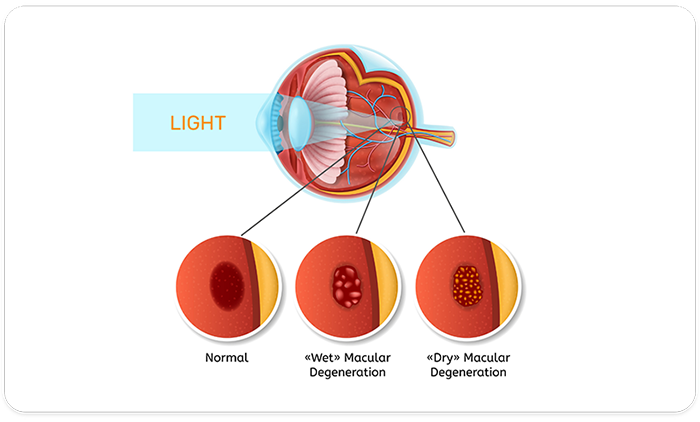What is Macular Degeneration?
Learn all you need to know about age-related macular degeneration-from wet vs. Dry to causes and treatments.
Click here to learn moreWhat to expect with Macular Degeneration.
Understand how your AMD might progress so you can be prepared while you work to limit vision loss.
Click here to learn moreWhat is Macular Degeneration?
AMD stands for Age-related Macular Degeneration. Sometimes people simply call it macular degeneration. It’s named after the macula, the small area in the back of your eye that’s responsible for central vision—what you see directly in front of you.
What You Need to Know About Macular Degeneration

To understand AMD, you must first understand the anatomy of your eyes. Your eye has a lens near the front that focuses light. When that light passes through the lens it lands at the back of your eye, the retina. The retina captures the shapes and colours of the light, to make an image for you to see.
The macula is the centre of the retina and it’s responsible for the clarity of the images you see and the vibrancy of their colours.
Having macular degeneration is like using a camera with film that’s partly damaged in the middle. AMD’s effect on your vision depends on the amount and type of damage, wet AMD or dry AMD, in your macula. No matter how advanced your macular degeneration is it mainly affects your central vision. AMD is unlikely to affect your peripheral or side vision.
Wet vs. Dry Macular Degeneration
Most people with macular degeneration have the more common form, dry AMD, in 1 or both eyes. In 1 out of 10 people, dry AMD progresses to wet AMD.
The Stages of Macular Degeneration
While there’s no way to cure macular degeneration, in some people it worsens slowly or stays the same for years. Macular degeneration can be divided into three major stages.

Early AMD
There is typically no change in vision but a doctor can see medium-sized drusen deposits during an eye exam.
Intermediate AMD
An eye exam will show larger drusen deposits or changes in the color of the retina. There may be no symptoms yet or some minor symptoms.
Advanced AMD
There are symptoms such as wavy or blurred vision, blind spots, and trouble seeing in low light situations. Advanced macular degeneration can be dry AMD or wet AMD.Managing Macular Degeneration
There’s no known way to repair the macula and reverse age-related macular degeneration, so managing AMD is geared toward stopping your condition from getting worse—or at least slowing its progression.
Quitting smoking, eating a diet geared toward macular health, and exercising are just 3 examples of what you can do to help protect your vision if you have dry AMD. You may also want to consider taking an AREDS2 formula vitamin that has been scientifically proven to reduce the risk of progression of the condition.
Wet AMD is typically treated with periodic injections into the eye, but doctors sometimes prescribe laser treatments or laser surgery.
What Causes Macular Degeneration?
You may be wondering why you developed AMD. So many factors can contribute to the condition that it’s impossible to say exactly which have played a role in yours. We do know that some risk factors are beyond our control.
Age
In Canada, AMD is the leading cause of vision loss in people over the age of 50, affecting approximately 1.4 million Canadians.Family history
Thanks to genetics, close relatives are 3 times more likely to develop macular degeneration.Gender
Women get AMD more often than men, but this difference may simply be because women tend to live longer than men.Skin Color
People with light skin are more likely to develop AMD than people with darker skin.Sun Exposure
UV rays from the sun may increase the risk of AMD; wearing sunglasses can protect your eyes.Smoking
People who smoke or live with smokers are considerably more likely to develop AMD.Obesity
Being obese is linked to a significant increase in the risk of AMD.Medications
Some antipsychotics and malaria treatments may increase the risk of AMD.Diet
A high-fat diet is linked to increased risk; some foods such as dark leafy greens, along with eyesight specific vitamins, may help protect your vision.Inactivity
Lack of aerobic exercise may be linked to macular degeneration; being active may slow its progression.Eyes
People with lighter-colored eyes may be at higher risk. Research shows that other risk factors for AMD and its progression may be within our control. You and your close family members can try to reduce these by making changes in your lives.High blood pressure and cholesterol levels
Unmanaged, these conditions can increase the risk of macular degeneration and its progression.What to expect with Macular Degeneration
Millions of people who are living with Age-related Macular Degeneration (AMD) were once asking this same question: What will my future look like? The answer unfortunately is, it’s hard to know. Most people over the age of 50 have some amount of drusen—the yellow-colored deposits that gather near the macula. In some people, the condition progresses very slowly and leads to little change in their vision. In others, AMD advances faster and may lead to some loss of vision in one or both eyes.
No one can predict your future with AMD, but it’s worth knowing everything you can about what may happennso that you can prepare yourself and your family —while also doing everything you can to try and limit your vision loss.
How macular degeneration may affect you
Everyone’s AMD journey is different but the stages that macular degeneration progresses through —if it progresses — and how each stage affects vision are usually the same. Besides vision-related symptoms, many people will experience a range of emotions as their condition advances, from shock upon first being diagnosed to fear and sadness. Sooner or later, most people come to terms with their diagnosis and resolve to do all they can to protect their vision, you will too.
Early dry macular degeneration
In the beginning, your doctor may detect small drusen deposits in your macula that can damage your eyes, though you may not notice any change in your vision. The drusen may be in one or both eyes.
What does it mean for me?
Some people with drusen never develop any central vision loss at all—while the drusen typically won’t disappear, it might not develop to a point where it causes problems. Therefore, many doctors recommend prevention strategies, such as vitamin supplementation, that may limit further damage to your macula.
Intermediate dry macular degeneration
Drusen deposits can slowly damage the macular cells and start to affect your central vision. If only one of your eyes is affected and your other eye compensates, you may not notice significant vision changes.
What does it mean for me?
You may notice a blurred spot in the center of your vision. Using a bright light will make reading and other closeup tasks easier and you may still be able to drive in the daytime. As your vision changes, you’re likely to feel a sense of loss and begin to fear for your future.
Just remember: You may have reached a plateau that can last for years.
Advanced dry macular degeneration
If your AMD progresses to the advanced stage, also known as geographic atrophy, which can happen over the course of many years or more rapidly, your central vision will likely be significantly affected by a blind spot in the center of your field of vision.
What does it mean for me?
Your central vision is how you’re able to see things in detail, how you read, write, do close work, use stairs, and recognize faces. So, with advanced AMD, daily tasks and activities can become hard to do. It’s a scary thought but with help, you can learn new ways of doing things by using your peripheral vision (AMD typically only affects your central vision) and trying various tools and resources that are available to you.
Click here to see tools and resourcesWet macular degeneration
About 1 in 10 people who have dry AMD go on to develop wet AMD, which can lead to significant vision loss. People with certain types of drusen deposits are more at risk of this form of the condition, even in the early stages of AMD, so ask your doctor. If your risk factor is higher, it’s especially important to monitor your vision on a weekly basis for any changes, because wet macular degeneration typically comes on suddenly but can be treated to limit the damage.
What does it mean for me?
In addition to central vision blurring, the wet form of AMD tends to drastically distort what you see directly in front of you. It may be harder to discriminate between light and dark tones, and colours may appear duller. Vision loss may be serious enough that you’ll need to make many adjustments in how you get by at home and outside—but prompt diagnosis and treatment can decrease risk of vision loss.

